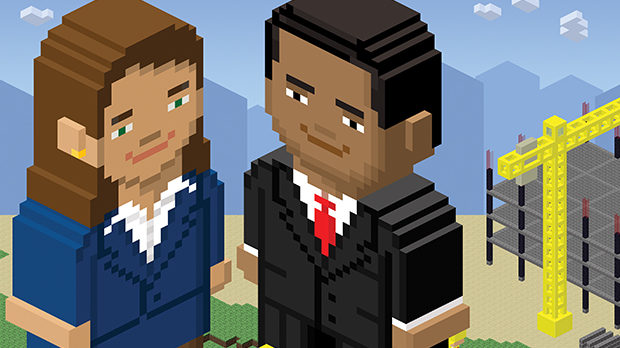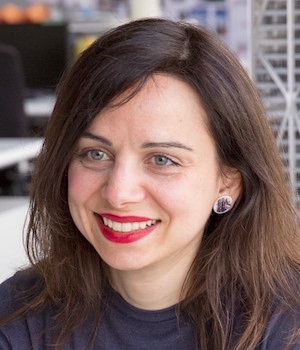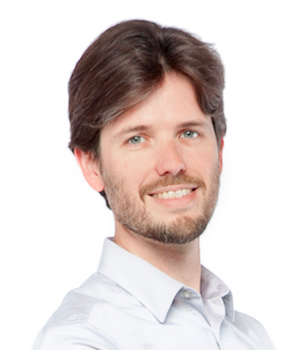
Martha Tsigkari and Adam Davis, partners in Foster + Partners’ Applied Research + Development group, talk to Denise Chevin about platform design and Minecraft on steroids.
The Applied Research + Development group at Foster + Partners is based in London and its 11 staff are involved in developing and exploring a number of innovative technologies across Foster’s offices worldwide. Tsigkari and Davis joined Foster in summer 2006.
What have been the key developments the group has worked on in the past 12 months?
Martha Tsigkari (MT): We have been focusing a lot on further developing applications around machine learning, optimisation, robotics, IoT and AR/VR. A lot of our activities are focused not only on how to enhance performance-driven design and remote design collaboration, but also of what happens with the data we produce – how we can develop applications with real-time feedback and how we can then use the data produced further down the line.
Data has become the currency of the modern society. It is, in many ways, the most abundantly generated product of the 21st century. Given the amount of proprietary, original data we have (50 years-worth of it), we are working through the process of trying to collect, process, classify and re-use it in a useful way.
Where we see a far better collection and use of data in the industry is during the operational stage of the building. Data collected from sensors during the life of a project allow us to monitor and measure its performance not only quantitatively, but also qualitatively.
Adam Davis (AD): We have been increasingly using our campus as a test-bed for many of the technologies Martha mentions. In the smart building context – to name one – this interaction between quantitative and qualitative data manifests as the matching of data about our environment – temperature, humidity, etc – to a record of how occupants feel about that environment, and how they behave in that environment.
How, if at all, has the development of technology been influenced by the pandemic – has this accelerated progress in any areas?
AD: Telepresence has benefited massively as a result of the pandemic. A lot of this benefit is simply exposure: workers – including designers – are now comfortable with creating, analysing and communicating at a distance in ways that were unthinkable to large numbers of people just months ago. We are using tools that were already available but not necessarily obviously applicable to their needs.
Of course, there is a lot of scope for improvement in these tools and that is what we are seeing as the pandemic continues into its second year. Our team are working on tools for designing and reviewing in interactive, immersive, collaborative digital spaces.
MT: For more than a decade, we have been investigating the use of AR and VR as collaboration tools that can enhance the design process, no matter the stakeholders’ geographical location. The progressive R&D our team has conducted in this domain has been instrumental in the way we embraced these new technologies with ease during the pandemic.

Data has become the currency of the modern society. It is, in many ways, the most abundantly generated product of the 21st century.– Martha Tsigkari, Foster + Partners
You have talked in the past about developing technologies that still allow for ‘human intuition’ – can you talk us through how this work is developing?
MT: Given our design approach in the office is centred on human experience and performance-driven design, our aim is to always develop applications, technologies and processes that can support these two pillars.
Human intuition needs to be at the heart of this. We cannot simply automate processes; we need to put our designers and their vast experience in the crux of the decision-making process. We have been developing interfaces that can provide real-time analytical feedback, which can then work as a collaborator and enhancer of human intuition.
We want technology to amplify not only our creativity, but also the way we experience and interact during the design process. We want to empower designers with tools and interfaces and help them explore new ways of solving problems, by using and simultaneously honing their intuition.
Our SandBox platform, developed using gaming engine software, is one such example: an interactive application that works as Minecraft on steroids, where the user can create and analyse various design solutions in an array of interfaces spanning from tablets, to touch screens or even AR and VR headsets.
By manipulating and designing a model in real time, hard metrics, including area, daylight, CO2, views and spatial connectivity, but also soft metrics, like wellbeing index and value, can be calculated allowing intuitive yet informed decision-making early on in the design process.
AD: In addition to creating interfaces that allow designers to express their intuition, we are also interested in more general intuitions about space that might be common among clients and the public.
We have developed technology and experimental procedures for capturing and analysing subjective judgements and we are engaging with our staff, clients and eventually the public to record and understand such judgements. We use these to inform everything from aesthetic appreciation of views to occupant reports regarding environmental comfort.
Government is keen to adopt a ‘platform approach’ to the design and construction of public building going forward – are you excited or dismayed by that?
AD: There are two possibly contradictory ways of thinking about this. On the one hand, interoperability is critical in design and construction, particularly given the great variation in materials, construction approach and other uncertainties involved in tendering projects. On the other hand, true agility can require freedom from specifications and constraints.
As a practice, we have worked internationally for decades and have long been leaders in innovation in design. Accordingly, our approach to standards varies across and even within projects. In some instances, we will benefit when there are clear outcomes, agreed from the outset and supported by a wide variety of possible participants in the design process. Other times, we find the best outcomes when we can free ourselves from established modes of designing and building.

We have developed technology and procedures for capturing and analysing subjective judgements and we are engaging with our staff and clients to record and understand such judgements.– Adam Davis, Foster + Partners
How do you think the skills needed in architectural practices will change in the coming five years?
AD: In the nearly 15 years we have been practising at Foster + Partners, certain technologies – particularly parametric design and environmental analysis – have gone from being niche skills to become an expected part of any architect’s training. Digital design is becoming less of a specialisation and more of a default approach to design.
AI, multi-objective optimisation and AR and VR are good examples. While we as an R&D team spend a lot of time on the details of implementing such technology, architects working on projects shouldn’t need to understand all of the technical underpinnings. Instead, I believe that architects will increasingly be exposed to the basics of such technology such that they can use them to their best potential in the course of a design project. And perhaps equally importantly, to know when not to use a particular technology!
MT: As Adam points out, the skillset of the architect has been going through a constant evolution in the past decade. The embrace of computational and performance-driven design has led to designers adopting a more renaissance approach to the profession (and themselves). The technology, not only as a facilitator but also as a creativity enhancer, is at the heart of this and hopefully will continue being so in the coming years.
In our group, people often ask us whether we see ourselves as designers or programmers – I don’t see why we need to choose one or the other. If Schrödinger’s cat can be two things at the same time inside the box, so can we!
Apart from Boston Dynamics’ robot dog, Spot, are their other interesting collaborations you can tell us about?
MT: We are certainly keen on instigating and maintaining strong collaborations with like-minded companies and people – both from the industry and academia – that want to push the boundaries of innovation. We feel that this integration of different disciplines can yield fantastic and unexpected results, as it always happens in the intersection of different approaches that invite cross-fertilisation of thinking.
We have been working closely with universities such as UCL and companies like McNeel and Autodesk on a number of projects. We have also enjoyed fruitful collaborations with companies such as Nvidia and Epic Games. We’re also reaching out to companies like DeepMind or ILM to exchange ideas with organisations that are at the top of their game and from whom we can learn as well.
Are you concerned that some technologies – such as digital twins – may be being overhyped?
AD: We try to look beyond the claims and understand the fundamental promise of various technologies. Specifically, with respect to digital twins, we think there are some great opportunities in maintaining close fidelity between digital representations and their real-world counterparts. Companies in this space are coming at this from all sorts of backgrounds – control systems, asset and facilities management, smart building, cloud computing – and accordingly each emphasise some features and capabilities while leaving others less developed.
Over time, we will likely see some of these approaches gain more traction and others fall away. That’s a typical pattern in technology adoption. It’s important not to ignore a whole category of technology simply because some of its constituents and proponents aren’t viable in the long run.
Life with Spot – read what Tsigkari and Davis had to say about the robotic dog: https://www.bimplus.co.uk/technology/foster-partners-best-friend-spot-robot-dog/
Portrait photography: Aaron Hargreaves/Foster + Partners











